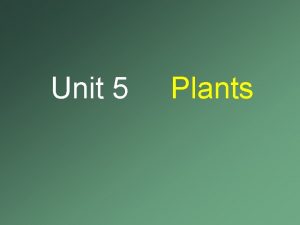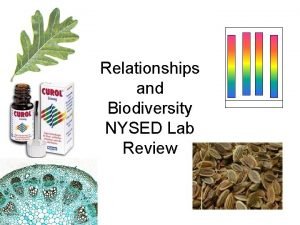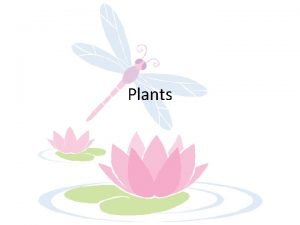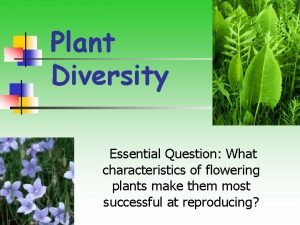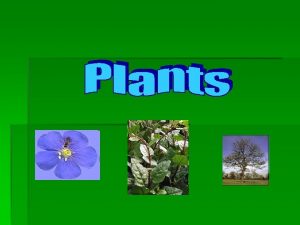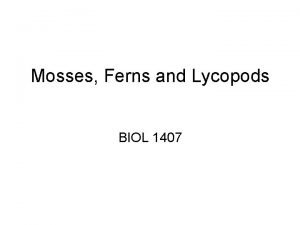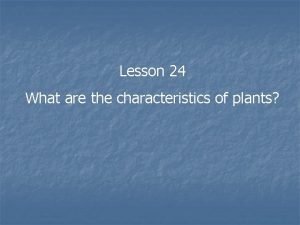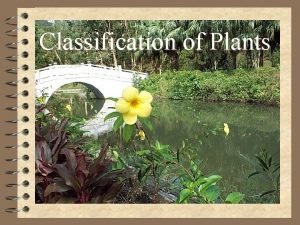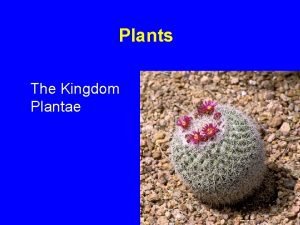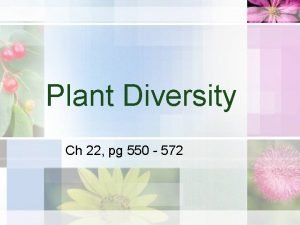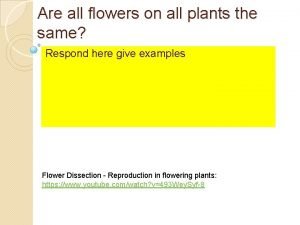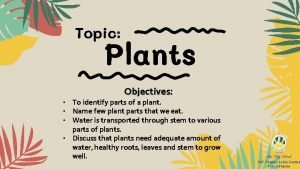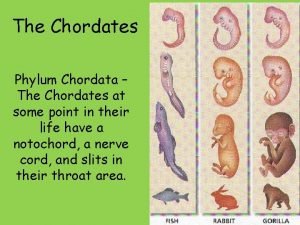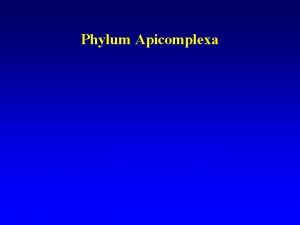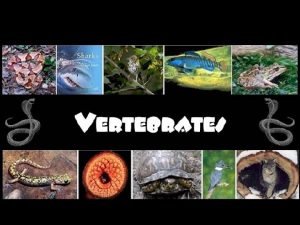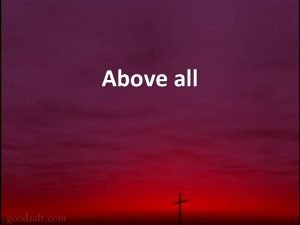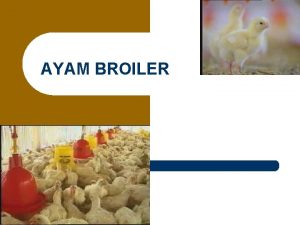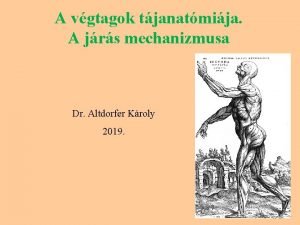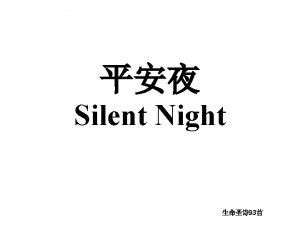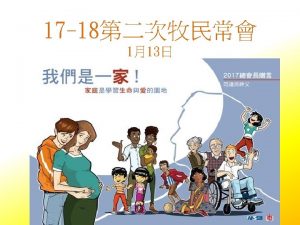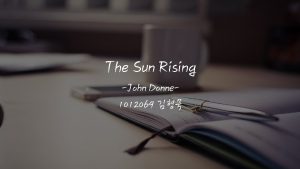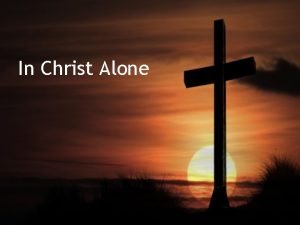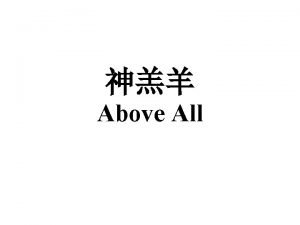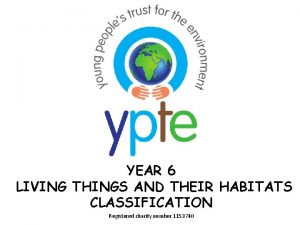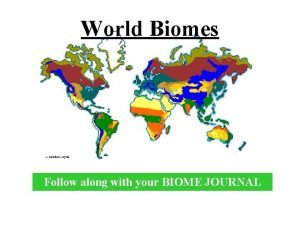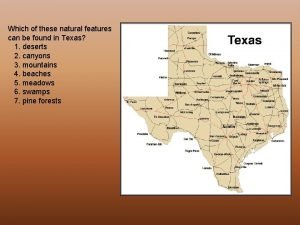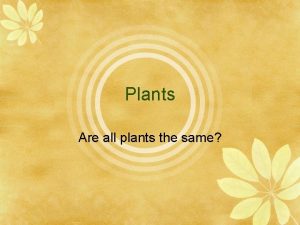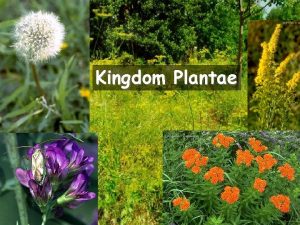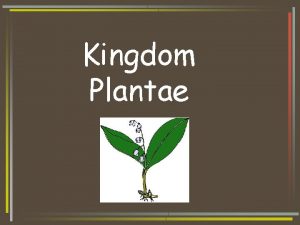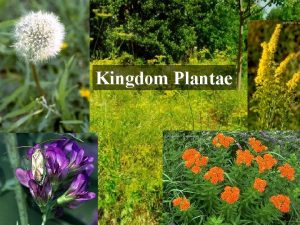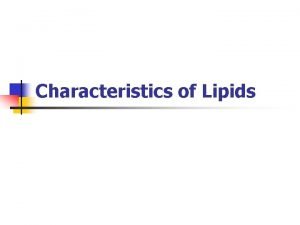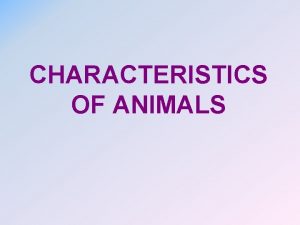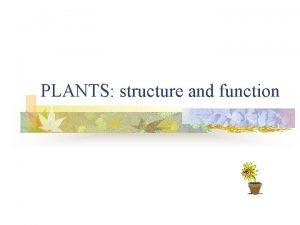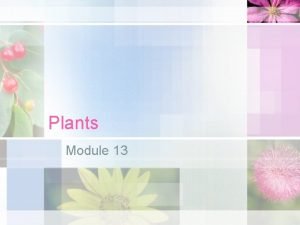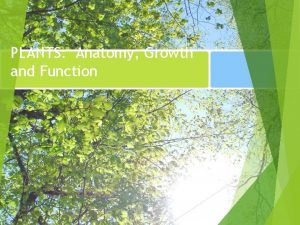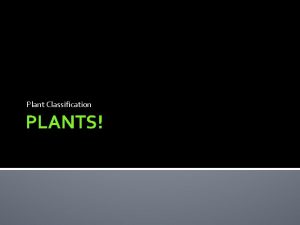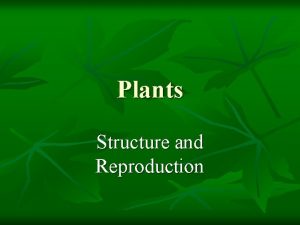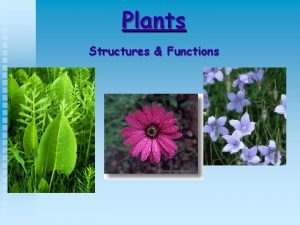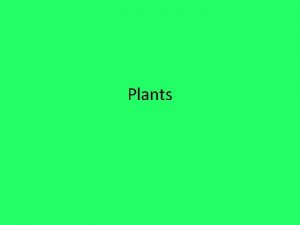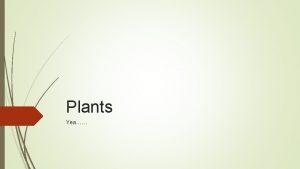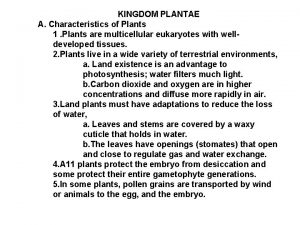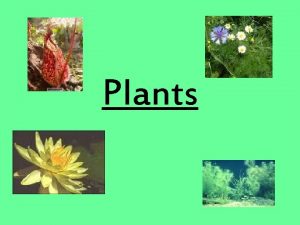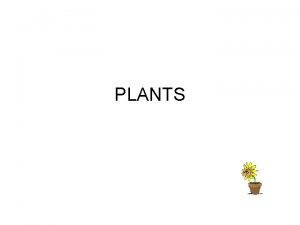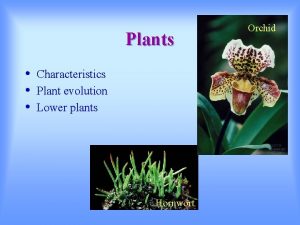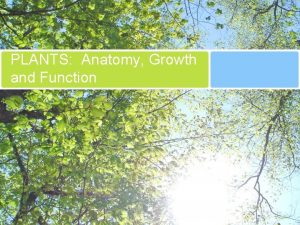Plants Characteristics of all plants 1 All are







































- Slides: 39

Plants

Characteristics of all plants 1. All are many celled (multi-cellular) 2. Contain chlorophyl/Chloroplasts. Photosynthesis 3. Cell walls.

2 main types of plants (Vascular & nonvascular) 1. Nonvascular • • oldest land plants, evolved first tissues do not transport water very short- need to stay close to water moist environments do not have true roots water is needed for reproduction sperm swims from male to female egg. Ex 1. mosses 2. liverworts Video- Mosses, ferns

Vascular plants Tissues are able to transport water to all parts of the plant. – Plants are able to get taller and farther away from water. – Most plants today are vascular.

• Vascular tissue • Xylem- Transports water from roots to leaves. • Phloem- Transports food(sugar) from leaves to the rest of the plant. • Cambium- makes new xylem & phloem tissue.

• Leaves • Used in photosynthesis • 6 H 2 O + 6 CO 2 6 O 2 + C 6 H 12 O 6 • Cuticle- Outer layer of the leaf, waxy, water proof & prevents water loss. • Photosynthesis- hyperlink

• Chloroplasts- structure that contains chlorophyl. • Chlorophyl is the dominant green pigment of a plant that is used in photosynthesis. .

Fall • Leaves change color in Fall because chlorophyl breaks down or is reabsorbed by plant. • Pigments that are less dominant become visible. • these colors have been in the leaves all along • We just can't see them in the summer, because they are covered up by the green chlorophyll

• Stomata- Openings on the underside of leaves that allows gas exchange • CO 2 - in O 2 & H 2 O - out • Transpiration – Loss of water through leaves (stomata)

• Deciduous Trees – • Lose leaves in the fall

• Leaf Terminology

• • Nonflowering Vascular Plants Tissues are able to conduct water No flowers Ex – Ferns, Grasses, Gymnosperms

• • • Gymnosperms (“Naked Seeds”) Most are cone bearing tree’s (pine cones) Produce seeds inside of a cone Seeds do not have a seed coat Also called conifers

• • Conifers – Cone bearing plants do not lose leaves in fall (evergreen) Cones – Male soft contains pollen (sperm) Female hard contains eggs (seed)

• Pollination – Wind takes pollen to female cone called pollination • A lot of pollen has to be produced most is wasted. • Ex – Pines, Firs, Cedars, etc.

• Angiosperm – Flowering Plants • Flowers make reproduction more efficient by promoting pollination • Flowers attract pollinators (bees, birds, bat, et) • Not as much pollen is produced or wasted. • Video- Gymnosperms & Angiosperms 2 min

Sepal –Protects budding flower – Base of flower Petals – Attract pollinators Stamens – Male part – produces pollen • Has 2 parts: • 1. Anther – pollen producing sac • 2. Filament

• Pistil – Female part – produces egg’s (3 parts) • 1. ) Stigma 2. ) Style 3. ) Ovary • Stigma – Top sticky for pollen (hair or sap) • Style – Middle part • Ovary – Bottom part – contains eggs

• Pollination – When pollen reaches the stigma (top part of the pistil) • Pollen Tube – Forms after pollination. Tube forms to take sperm from stigma through style and down to the ovary to fertilize eggs.

• Fertilization – • When the sperm reaches the egg and unites with it. • After fertilization a seed forms

Seed – contains 1. )Seed coat 2. )Embryo 3. )Cotyledon • Seed Coat – outer protective coat

Embryo • Embryo – undeveloped plant (baby) • - has 2 parts 1. )Epicotyl 2. ) Hypocotyl • Epicotyl – top part of embryo that forms the leaves • Hypocotyl – forms the root and stem of the embryo • Cotyledon – contains the stored food for the embryo • the embryo uses the food in the cotyledons to grow until it can produce food by photosynthesis

• Dormant – seed not growing Germination – when conditions become suitable for growth and the embryo starts to grow inside a seed. (right amount of water, temp, etc. ) • Video- Life cycle of flowering plants 5 min

Poison Ivy





Poison Ivy • Poison Ivy is a woody shrub or vine with hairy looking roots. • All parts are toxic. • Toxin is an oil. • Causes skin reaction • Reaction can vary in severity from people to people and year to year.

• Treatment • Wash well with soap A. S. A. P. • Change clothes and wash them. • • • Identification 3 divided leaves. Center leaflet is on a longer stem. Leaves alternate on the stem. Mature plants have white waxy berries.


Poison Ivy Spring

Summer

Fall

It creeps

In Vines on tree’s

Where does it grow?

On the Ground

Beach
 Antigentest åre
Antigentest åre Characteristic of plantae
Characteristic of plantae Nonvascular plant
Nonvascular plant Non vascular plants
Non vascular plants Examples of non flowering plants
Examples of non flowering plants Photosynthesis equation
Photosynthesis equation Name all the rays
Name all the rays Xylem tissue
Xylem tissue Nys biodiversity lab
Nys biodiversity lab Characteristics of plants
Characteristics of plants Characteristics of plants
Characteristics of plants Characteristics of plants
Characteristics of plants Sporophyte vs gametophyte
Sporophyte vs gametophyte Hornwarts
Hornwarts Non flowering plants classification
Non flowering plants classification Kingdom plantae characteristics
Kingdom plantae characteristics Plants
Plants Genesis all seed bearing plants
Genesis all seed bearing plants Parts of a female flower
Parts of a female flower All about plants
All about plants Do all plants have roots
Do all plants have roots What are the 4 characteristics of chordates?
What are the 4 characteristics of chordates? Select all the characteristics of apicomplexans
Select all the characteristics of apicomplexans Which is characteristic of all vertebrates?
Which is characteristic of all vertebrates? Love all serve all help ever hurt never meaning in hindi
Love all serve all help ever hurt never meaning in hindi Interventi sociali rivolti all'infanzia e all'adolescenza
Interventi sociali rivolti all'infanzia e all'adolescenza Above all powers above all kings
Above all powers above all kings I work all night
I work all night All to one reduction
All to one reduction Sistem all in all out
Sistem all in all out Regio palmaris
Regio palmaris Silent night holy night all is calm all is bright
Silent night holy night all is calm all is bright 馮定華
馮定華 All of you is more than enough for all of me
All of you is more than enough for all of me She's all states and all princes i nothing else is
She's all states and all princes i nothing else is What heights of love what depths of peace
What heights of love what depths of peace Above all powers
Above all powers Classification of plants
Classification of plants Taiga biome plant adaptations
Taiga biome plant adaptations Average annual rainfall in south texas brush country
Average annual rainfall in south texas brush country







